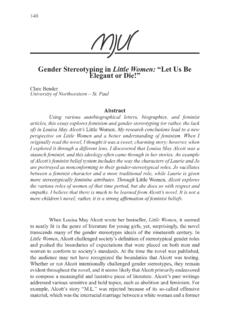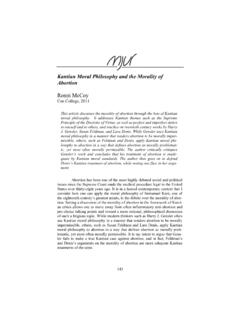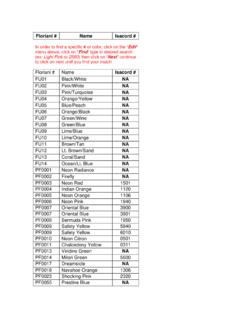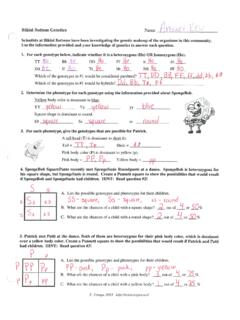Transcription of The Pink Tax: The Persistence of Gender Price Disparity
1 56 The pink Tax: The Persistence of Gender Price DisparityMackenzi LaffertyMonmouth CollegeMackenzi Lafferty is an alumna of Monmouth College in Monmouth, Illinois (Class of 2019), where she received a Bachelor of Arts in International Business and Political Science with a minor in economics. She is currently pursuing a master s degrees in international business and business analytics at Hult International Business School in Boston, Massachusetts. Lafferty s studies in political science and international business led to her passion for international trade, and she hopes her study of the pink Tax may help to educate consumers about their purchase making and bring to light the issue of global Gender Price Disparity .
2 Lafferty is ultimately interested in a career in international trade, specifically in import and export management and international pink tax is an extra amount that women pay daily as consumers for products and services that are similar or equal in merit to comparable men s products. Due to gendered services and products such as BIC for Her Pens, women are being subjected to unfair Price standards. The question Why is the pink tax continuing to persist within society and contributing to Gender Price Disparity ?
3 Will be further examined in this research. Economic Gender discrimination is persisting within society due to the ingrained acceptance of cultural expectations of the genders. Cultural expectations are propagated by the media and directly marketed to females. Legislation within the , both at the federal and state levels as well as abroad, outwardly accepts the Gender -based discrimination of consumers. Current trade policy and the higher tariff rates of women s imported goods also help to explain the Persistence of this discrimination.
4 Process tracing is used in order to dissect the causation of the pink tax throughout history. Case analyses are used to represent the vast effects of pink sales. This research will provide awareness of a tax deemed hidden within the daily lives of Journal of Undergraduate Research 2019, Issue 11 Lafferty 57 Research Question Why is the pink tax continuing to persist within society and contributing to gendered Price Disparity ? PART I: Introductory MaterialI. IntroductionI-1. Research SignificanceWomen s products are more than twice as likely to be priced higher than comparable men s products to the degree that comparable products targeted to opposing genders are only equal in Price approximately 40% of the time (Joint Economic Committee: Congress, 2016).
5 The pink tax can be understood as the extra tax that women must pay within their daily lives as they consume products that are necessary in pursuance of society seeing them as appealing and feminine. Many are unaware or uneducated regarding the reasoning and Persistence of this tax within society; therefore, it is branded as a hidden tax. The tax is instituted in such a way that women are charged extra for products and services targeted toward the female Gender .
6 These products tend to be of equal or lesser merit than comparable products targeted to men. For this research, women s products are generally labeled as all products that are campaigning to help women. As pink has been outwardly regarded in society as the hue of femininity, most of these products consist of pink packaging and/or features. From women s razors to BIC for Her Pens, this tax is subjecting women to unfair Price standards. It is debated from where this tax specifically stems within history, but its origin does not change the implications to all females regardless of their affinity for feminine appearing products.
7 Therefore, the question, Why is the pink tax continuing to persist within society and contributing to gendered Price Disparity ? , will be further examined within this research. All females are in some way experiencing discrimination in the form of Gender pricing, making this research intrinsically Overview: Why the pink Tax is PersistingFrom the blatant branding and marketing ploys of large corporations that continue to project Gender expectations on all ages, to societal pressures on women to uphold certain physical characteristics in fear of the possibility of being unworthy of success, societal structures and norms are a huge contributing factor of this commonly accepted discrimination.
8 Furthermore, specific laws and trade policies beginning with the importing of products from abroad also can be blamed for the continuing economic strain and Disparity for female consumers. 58 LaffertyTherefore, both state and federal laws within the are also examined, as well as laws abroad, which showcase small steps toward solutions to this injustice. Instances of import tariffs are further examined as well, specifically within the fashion industry. The pink tax is measured in numerous ways.
9 For the purpose of this research, the tax is measured in terms of how much more money it is forcing a woman to spend if she does indeed choose to buy products specifically targeted toward the supposed needs of the female Gender . These everyday items include, but are not limited to: clothes, office supplies, basic self-care items, and some services such as vehicle maintenance, dry cleaning, public transportation and hair styling (Rapier, 2018). Many women who are aware of this tax have simply begun buying products targeted to the male Gender , but this is not a true solution.
10 True solutions include: the de-gendering of basic products, seeking legislative action to extinguish Gender discriminatory laws which allow for gendered Price discrimination and fixing, the education of consumers, and changing import tariffs to alleviate financial burdens on women. The Persistence of consumer Price Disparity of women must be identified and de-rationalized for true change to take place and further the equalization of Research OutlineThe first part of this research will begin by providing concise background of the pink tax including a clear definition of the tax, as well as a differentiation from the luxury tax.







